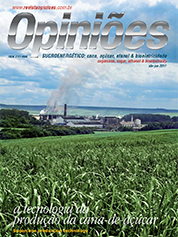Leila Luci Dinardo-Miranda
Director of the R&D Unit at the Sugarcane Center of IAC
Op-AA-28
Pests and the green sucarcane scenario
Much has been debated, and still is, about alterations concerning the occurrence of pests due to change in the harvesting system, which from the manual harvesting of burnt sugarcane switched to the mechanical harvesting of green sugarcane. As a result of the harvesting of green sugarcane, there has been a considerable increase in the quantity of straw in the fields, changing the ecosystem. One should expect this change to have positive impacts on some pests and negative ones on others.
By the same token, changes of the ecosystem may benefit or hurt beneficial insects, predators and pest parasitoids and, again, interfere in relations of pests/natural enemies, with consequences for the populations of the former. There are few scientific studies on this subject, but, in practice, two major changes have already been noticed that are, undoubtedly, the two most important in terms of consequences for green sugarcane harvesting in pest areas.
The best known is the Mahanarva fimbriolata, the spittlebug. This pest has always been present in our sugarcane plantations, but until the end of the 90’s, when almost all sugarcane plantations were harvested manually after they were burnt, it only rarely caused any damage. Due to this, it was considered a pest of secondary importance.
With the growth in the planted green sugarcane harvest area, populations increased quickly and nowadays the spittlebug is found in practically all sugarcane plantations, both in green sugarcane ratoons and in those of plant-cane. This pest is economically very important because it causes considerable reductions in agricultural productivity and in raw material quality, and noticeably interferes in industrial processes.
Fortunately, much information is available on this pest. Parameters for successful management, such as sampling methods, economic damage level, efficiency of control measures, are well known. Naturally, there is still a lot to be learned about this pest. Some aspects, such as how certain varieties behave, the occurrence of insect resistance to pesticides, etc., must constantly be investigated, although the groundwork for integrated management is available to all.
Although the importance of the spittlebug in the green sugarcane scenario cannot be disputed, reason for greater concern is the Sphenophorus levis. Until the end of the 70’s, this pest was restricted to the region around Piracicaba, but was then disseminated to other production regions through seedlings brought from infested places.
Nowadays, it can be found throughout the State of São Paulo, North of the State of Paraná and in the State of Minas Gerais. It is probably also in the State of Goiás and other states, albeit as yet no occurrences have been registered in those areas. Adults of this type of pest live long and are always crawling on the ground protecting themselves under crop leftovers and weeds.
In times when burnt cane was harvested, many adults perished because of the fire. With the harvesting of green sugarcane, not only do adults no longer die in the fire, the straw in the fields shelters them. Due to that, populations increased quickly and, in some regions, sugarcane plantations were wiped out after one or two green cane cuts.
Concern about this pest are justified because it is extremely damaging and control measures are not very efficient. The destruction of infested ratoons and the application of pesticides, both in plantation and on ratoons, help to maintain the sugarcane plantation, but are far from being a definitive solution for the problem. Biological control has also been assessed, but, until now, it stands as an auxiliary management instrument.
Thus, the Sphenophorus levis is likely to become the major obstacle in green sugarcane areas (but not only there), given that there is no simple solution in the short and medium terms. With respect to all other pests, including the cane borer Diatraea saccharalis, woodworms, and Migdolus, the impact on green sugarcane was minor or none, which is why their status remained unchanged in green sugarcane areas.
Indeed, borer populations increased greatly in recent years, but this may mainly have been due to the use of more sensitive varieties and the lack of control in many areas. Green sugarcane was less affected. It is quite likely that the giant borer, Telchin licus, also benefits from straw, given that control will probably be more difficult. But, for the time being, nothing can be stated. We need to study the matter in more detail.




